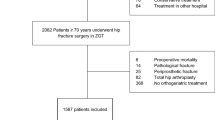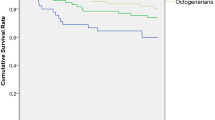Abstract
Background
Surgical management of geriatric hip fractures yields improved functional outcomes with decreased morbidity and mortality. Cohort studies have suggested that the older patients within the geriatric age group have worse outcomes with surgery, However, these studies inherently report inflated risks due to poor handling of confounders and have inadequately age-stratified their geriatric population.
Aim
This study aims to investigate the effect of age alone on the 1-year mortality and functional status of geriatric patients after hip fracture surgery.
Methods
This is a retrospective single institution cohort study based on the prospectively-maintained registry of hip fracture patients. 2603 patients aged 60 years and above were treated surgically under a geriatric–orthopaedic hip fracture pathway from January 2014 to December 2018. Patients were split into two age groups: ultra-old (≥ 85 years) vs old (< 85 years). Baseline demographics and the ASA (American Society of Anaesthesiologists) status and the Modified Barthel’s Index (MBI) were obtained at admission and 1 year after the fracture. Adverse outcomes from the fracture and surgery were recorded during a follow-up period of minimally 2 years. A 2:1 matching process based on the gender, fracture type, ASA status, CCI and MBI categories was conducted.
Results
There were 1009 and 515 patients in the old and ultra-old age groups, respectively. 1-year mortality was similar for both age groups (4.0% ultra-old vs 3.6% old, p = 0.703). 30-day morbidity was similar except for higher rates of postoperative pneumonia in the ultra-old (14.0 vs 6.3%, p < 0.001). MBI scores at 1-year were lower in the ultra-old (severe dependence: 16.4 vs 10.0%; p = 0.001). Ultra-old patients were less likely to be community ambulant at 12 months (21.2 vs 36.0%) with the deterioration in ambulatory status significant after correction for baseline status (p < 0.001).
Conclusion
The 1-year mortality of surgically-managed geriatric hip fracture patients older than 85 years of age is not determined by age alone. Patients aged 85 years and above are at higher risk for pneumonia postoperatively. Ultra-old hip fracture patients with an intertrochanteric fracture are more likely to have poorer function at 1 year after hip fracture surgery.


Similar content being viewed by others
References
Tay YW, Hong CC, Murphy D (2014) Functional outcome and mortality in nonagenarians following hip fracture surgery. Arch Orthop Trauma Surg 134(6):765–772. https://doi.org/10.1007/s00402-014-1982-z
Ovidiu A, Stefan GT, Dragos P, Bogdan V, Dana AI (2017) Survival of nonagenarian patients with hip fractures: a cohort study. Acta Ortop Bras Jul-Aug 25(4):132–136. https://doi.org/10.1590/1413-785220172504167561
Barcelo M, Francia E, Romero C, Ruiz D, Casademont J, Torres OH (2018) Hip fractures in the oldest old. Comparative study of centenarians and nonagenarians and mortality risk factors. Injury. 49(12):2198–2202. https://doi.org/10.1016/j.injury.2018.09.043
Bokshan SL, Marcaccio SE, Blood TD, Hayda RA (2018) Factors influencing survival following hip fracture among octogenarians and nonagenarians in the United States. Injury 49(3):685–690. https://doi.org/10.1016/j.injury.2018.02.004
Bolton D, Bush C, Wallace MT (2021) Nonagenarian hip fractures: morbidity and mortality at a single institution. J Clin Orthop Trauma 14:69–73. https://doi.org/10.1016/j.jcot.2020.09.020
Bovonratwet P, Yang BW, Wang Z, Ricci WM, Lane JM (2020) Operative fixation of hip fractures in nonagenarians: is it safe? J Arthroplasty 35(11):3180–3187. https://doi.org/10.1016/j.arth.2020.06.005
de Leur K, Vroemen JP, Vos DI, Elmans L, van der Laan L (2014) Outcome after osteosynthesis of hip fractures in nonagenarians. Clin Interv Aging 9:41–49. https://doi.org/10.2147/CIA.S52083
Graver A, Merwin S, Collins L, Kohn N, Goldman A (2015) Comorbid profile rather than age determines hip fracture mortality in a nonagenarian population. HSS J 11(3):223–235. https://doi.org/10.1007/s11420-015-9435-y
Kim JW, Kim DH, Jang EC, Lee YK, Koo KH, Ha YC (2019) Mortality and its risk factors in nonagenarians after hip fractures. J Orthop Sci 24(5):850–854. https://doi.org/10.1016/j.jos.2019.02.019
Lin JC, Liang WM (2017) Mortality, readmission, and reoperation after hip fracture in nonagenarians. BMC Musculoskelet Disord. 18(1):144. https://doi.org/10.1186/s12891-017-1493-5
Liu Y, Zhang CW, Zhao XD (2020) Long-term survival of femoral neck fracture patients aged over ninety years: arthroplasty compared with nonoperative treatment. BMC Musculoskelet Disord. 21(1):217. https://doi.org/10.1186/s12891-020-03249-7
Mayordomo-Cava J, Abasolo L, Montero-Fernandez N, Ortiz-Alonso J, Vidan-Astiz M, Serra-Rexach JA (2020) Hip Fracture in nonagenarians: characteristics and factors related to 30-day mortality in 1177 patients. J Arthroplasty 35(5):1186–1193. https://doi.org/10.1016/j.arth.2019.12.044
Miller AG, Bercik MJ, Ong A (2012) Nonagenarian hip fracture: treatment and complications. J Trauma Acute Care Surg 72(5):1411–1415. https://doi.org/10.1097/TA.0b013e318246f3f8
Sanz-Reig J, Lizaur-Utrilla A, Serna-Berna R (2012) Outcomes in nonagenarians after hemiarthroplasty for femoral neck fracture. a prospective matched cohort study. Hip Int. 22(1):113–8. https://doi.org/10.5301/HIP.2012.9080
Weinberg L, Ou Yang B, Cosic L et al (2021) Factors influencing early and long-term survival following hip fracture among nonagenarians. J Orthop Surg Res. 16(1):653. https://doi.org/10.1186/s13018-021-02807-6
Ogawa T, Schermann H, Kobayashi H, Fushimi K, Okawa A, Jinno T (2021) Age and clinical outcomes after hip fracture surgery: do octogenarian, nonagenarian and centenarian classifications matter? Age Ageing. https://doi.org/10.1093/ageing/afab137
Novoa-Parra CD, Hurtado-Cerezo J, Morales-Rodriguez J, Sanjuan-Cervero R, Rodrigo-Perez JL, Lizaur-Utrilla A (2019) Factors predicting one-year mortality of patients over 80 years operated after femoral neck fracture. Rev Esp Cir Ortop Traumatol (Engl Ed) 63(3):202–208. https://doi.org/10.1016/j.recot.2018.10.007 (Factores predictivos de la mortalidad al ano en pacientes mayores de 80 anos intervenidos de fractura del cuello femoral)
Charlson ME, Pompei P, Ales KL, MacKenzie CR (1987) A new method of classifying prognostic comorbidity in longitudinal studies: development and validation. J Chronic Dis 40(5):373–383. https://doi.org/10.1016/0021-9681(87)90171-8
Wijeysundera DN, Finlayson E. 2020 Preoperative Evaluation. Miller's Anesthesia. 12 ed.:918–988:chap 31
Ng JPH, Ho SWL, Yam MGJ, Tan TL (2021) Functional outcomes of patients with schizophrenia after hip fracture surgery: a 1-year follow-up from an institutional hip fracture registry. J Bone Joint Surg Am 103(9):786–794. https://doi.org/10.2106/JBJS.20.01652
Shah S, Cooper B, Maas F (1992) The Barthel Index and adl evaluation in stroke rehabilitation in Australia, Japan, the UK and the USA. Aust Occup Ther J 39(1):5–13. https://doi.org/10.1111/j.1440-1630.1992.tb01729.x
Zhang C, Feng J, Wang S et al (2020) Incidence of and trends in hip fracture among adults in urban China: a nationwide retrospective cohort study. PLoS Med 17(8):e1003180. https://doi.org/10.1371/journal.pmed.1003180
Takusari E, Sakata K, Hashimoto T, Fukushima Y, Nakamura T, Orimo H (2021) Trends in hip fracture incidence in japan: estimates based on nationwide hip fracture surveys from 1992 to 2017. JBMR Plus 5(2):e10428. https://doi.org/10.1002/jbm4.10428
Chandran M, Lau TC, Gagnon-Arpin I et al (2019) The health and economic burden of osteoporotic fractures in Singapore and the potential impact of increasing treatment rates through more pharmacological options. Arch Osteoporos. 14(1):114. https://doi.org/10.1007/s11657-019-0664-4
Bentler SE, Liu L, Obrizan M et al (2009) The aftermath of hip fracture: discharge placement, functional status change, and mortality. Am J Epidemiol 170(10):1290–1299. https://doi.org/10.1093/aje/kwp266
Ouellet JA, Ouellet GM, Romegialli AM et al (2019) Functional outcomes after hip fracture in independent community-dwelling patients. J Am Geriatr Soc 67(7):1386–1392. https://doi.org/10.1111/jgs.15870
Bohl DD, Sershon RA, Saltzman BM, Darrith B, Della Valle CJ (2018) Incidence, risk factors, and clinical implications of pneumonia after surgery for geriatric hip fracture. J Arthroplasty. 33(5):1552-1556 el. https://doi.org/10.1016/j.arth.2017.11.068
Simons AE, Karres J, Nijland LMG, Ultee JM, Kerkhoffs G, Vrouenraets BC (2017) Do-not-resuscitate orders and early mortality in hip fracture patients. Age Ageing 46(6):946–951. https://doi.org/10.1093/ageing/afx027
Lee WQ, Tan VKM, Choo HMC et al (2019) Factors influencing patient decision-making between simple mastectomy and surgical alternatives. BJS Open 3(1):31–37. https://doi.org/10.1002/bjs5.50105
Tan KY, Chen CM, Ng C, Tan SM, Tay KH (2006) Which octogenarians do poorly after major open abdominal surgery in our Asian population? World J Surg 30(4):547–552. https://doi.org/10.1007/s00268-005-0224-5
Tan CMP, Park DH, Chen YD, Jagadish MU, Su S, Premchand AXR (2020) Mortality rates for hip fracture patients managed surgically and conservatively in a dedicated unit in Singapore. Arch Orthop Trauma Surg. https://doi.org/10.1007/s00402-020-03605-1
Rasappan K, Chua ITH, Tey JBL, Ho SWL (2021) The continuous infusion fascia iliaca compartment block: a safe and effective analgesic modality in geriatric hip fracture patients. Arch Orthop Trauma Surg 141(1):29–37. https://doi.org/10.1007/s00402-020-03450-2
Wang CG, Qin YF, Wan X, Song LC, Li ZJ, Li H (2018) Incidence and risk factors of postoperative delirium in the elderly patients with hip fracture. J Orthop Surg Res. 13(1):186. https://doi.org/10.1186/s13018-018-0897-8
Xu W, Ma H, Li W, Zhang C (2021) The risk factors of postoperative delirium in patients with hip fracture: implication for clinical management. BMC Musculoskelet Disord. 22(1):254. https://doi.org/10.1186/s12891-021-04091-1
Yang Y, Zhao X, Dong T, Yang Z, Zhang Q, Zhang Y (2017) Risk factors for postoperative delirium following hip fracture repair in elderly patients: a systematic review and meta-analysis. Aging Clin Exp Res 29(2):115–126. https://doi.org/10.1007/s40520-016-0541-6
Milte R, Ratcliffe J, Miller M, Whitehead C, Cameron ID, Crotty M (2013) What are frail older people prepared to endure to achieve improved mobility following hip fracture? A Discrete Choice Experiment. J Rehabil Med 45(1):81–86. https://doi.org/10.2340/16501977-1054
Torpilliesi T, Bellelli G, Morghen S et al (2012) Outcomes of nonagenarian patients after rehabilitation following hip fracture surgery. J Am Med Dir Assoc. 13(1):81 e1–5. https://doi.org/10.1016/j.jamda.2011.02.006
Maggi S, Siviero P, Wetle T et al (2010) A multicenter survey on profile of care for hip fracture: predictors of mortality and disability. Osteoporos Int 21(2):223–231. https://doi.org/10.1007/s00198-009-0936-8
Ortiz-Alonso FJ, Vidan-Astiz M, Alonso-Armesto M et al (2012) The pattern of recovery of ambulation after hip fracture differs with age in elderly patients. J Gerontol A Biol Sci Med Sci 67(6):690–697. https://doi.org/10.1093/gerona/glr231
Acknowledgements
The paper has not been funded by any grants. The paper, or any part thereof, has also not been presented at a prior conference.
Author information
Authors and Affiliations
Corresponding author
Ethics declarations
Conflict of interest
The authors do not declare any conflicts of interest.
Ethical approval
The study obtained ethics approval from the institutional ethics board (NHG DSRB Reference number 2021/00658).
Informed consent
Waiver of informed consent was granted in the ethics approval.
Additional information
Publisher's Note
Springer Nature remains neutral with regard to jurisdictional claims in published maps and institutional affiliations.
Rights and permissions
About this article
Cite this article
Ng, J.P.H., Tan, T.L., Pillai, A. et al. Outcomes of ultra-old vs old patients after hip fracture surgery: a matched cohort analysis of 1524 patients. Arch Orthop Trauma Surg 143, 3145–3154 (2023). https://doi.org/10.1007/s00402-022-04550-x
Received:
Accepted:
Published:
Issue Date:
DOI: https://doi.org/10.1007/s00402-022-04550-x




